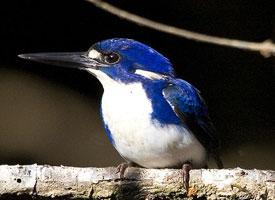
Poids et mesures
| Longueur | de 11 à 13 cm |
|---|
Description de l'animal
The Little Kingfisher (Ceyx pusillus) is a captivating avian species that belongs to the Alcedinidae family, which is renowned for its vividly colored members, often referred to as kingfishers. This particular species stands out for its diminutive size and striking appearance, making it a subject of fascination among bird enthusiasts and nature lovers alike.One of the smallest members of its family, the Little Kingfisher measures a mere 10 to 12 centimeters in length. Despite its modest size, this bird boasts a dazzling plumage that is a visual delight. The upper parts of its body shimmer in iridescent blue and violet hues, creating a stark contrast with the creamy-white underparts. The vibrant blue extends down the bird's back and is especially pronounced on its rump and tail, adding to its enchanting appearance. A distinctive feature is the bird's white throat, which is bordered by a narrow black band, adding an elegant touch to its overall look.
The Little Kingfisher's bill is another point of interest, being disproportionately large in comparison to its body size. This feature is typical of kingfishers and is perfectly adapted for its hunting lifestyle. The bill is dagger-like, allowing the bird to skillfully catch its prey, which primarily consists of small fish and aquatic insects. The bird's keen eyesight aids in spotting prey from a perch before diving in to capture it with remarkable precision.
Found across Northern Australia, New Guinea, and surrounding islands, the Little Kingfisher favors habitats that are close to water bodies such as rivers, creeks, and mangroves. This preference for aquatic environments is intrinsic to its feeding habits and breeding behavior. The bird is known to be quite territorial, especially during the breeding season, and it utilizes natural cavities near water bodies to nest and raise its young.
The Little Kingfisher's call is a soft, high-pitched whistle, which adds an auditory charm to its presence. This call is often heard during the early morning or late evening, contributing to the serene ambiance of its natural habitat.
Despite its beauty and intrigue, the Little Kingfisher leads a relatively elusive life, making sightings a rare and rewarding experience for birdwatchers. Its ability to blend into its surroundings, combined with its small size and quick movements, makes it a challenge to spot.
Conservation efforts are crucial for the survival of the Little Kingfisher, as habitat destruction and water pollution pose significant threats to its population. Protecting the water-rich environments that this species calls home is essential for ensuring its continued existence in the wild.
In summary, the Little Kingfisher is a small but spectacular bird, whose vibrant colors, distinctive features, and fascinating behaviors make it a jewel among kingfishers. Its presence enhances the biodiversity of its habitat, and its conservation is vital for the ecological balance of the regions it inhabits.
Animaux similaires
Nouvelles photos d'animaux
Top 10 des animaux
- Dolphin gull (Leucophaeus scoresbii)
- Diana monkey (Cercopithecus diana)
- Moustached guenon (Cercopithecus cephus)
- Galápagos tortoise (Geochelone nigra complex)
- Japanese macaque (Macaca fuscata)
- Stone loach (Barbatula barbatula)
- Russian tortoise (Testudo horsfieldii)
- Greek tortoise (Testudo graeca)
- Common flying dragon (Draco volans)
- Vendace (Coregonus albula)
